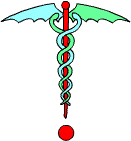The Post Quiz: Medicine and Advertising – Answers
Created | Updated Aug 27, 2012
If you got through all that, you have a strong stomach and a burning curiosity that we find laudable. How well did you do on the quiz?
The Post Quiz: Medicine and Advertising – Answers

1. In 1912, what was believed (by doctors) to be the most common cause of erectile dysfunction?
1. a. Playing with yourself. You knew that, didn't you? According to patent medicine adverts, at least, doing that wouldn't cure your acne. It would make you blind, insane, and ultimately impotent. It was called 'self-abuse', and it was naughty. So stop it.
2. In 1912, what cure was being offered for erectile dysfunction?
2. d. A suppository. Well, it wasn't inserted in the, er, usual place, but according to ' Manhood Perfectly Restored", the brochure of the Civiale Remedial Agency, the insertion of 'urethral crayons' would work wonders for your love life. There are pictures. From Gray's Anatomy. (We spare you.) There was a tonic, too, with laxatives in. Now, won't this make you rethink your reaction to those pill ads in your spambox?
3. As a selling point for surgical instruments in 1912, you should mention what place as their point of origin?
3. b. Germany. 'Everybody' knew that Solingen steel was the best, and German craftsmanship the finest.
4. What did the products of the Cluthe Rupture Institute have in common with exercise belts advertised in modern infomercials?
4. c. They claimed to use massage to tone muscles. The Cluthe Rupture Institute of Bloomfield, New Jersey (a suburb of New York City, according to the advert) claimed that their trusses eliminated the need for pesky exercise. Just move along normally, and the rupture would heal. From this pamphlet's numerous endorsement letters, one gets the feeling that a lot of people needed trusses in 1912. Maybe exercise would have been a good idea?
5. What complaint was Lydia Pinkham's Vegetable Compound designed to treat?
b. Painful periods in women. Mrs Pinkham, a Quaker lady from Massachusetts, first made her tonic for sale in 1876. Before she had a factory, she used her kitchen stove. The ingredients included Black Cohosh. It wouldn't hurt you, and the alcohol in it was relaxing.
6. Why do feminists praise Lydia Pinkham?
c. She shared information on women's health issues. Mrs Pinkham used to answer all the letters she got, and she wrote most of her advertising. This pamphlet contains recipes. Pinkham's company provided a much-needed source of information on women's health issues at a time when the medical profession was, frankly, uninterested.
7. When did the first patent medicine appear in the US?
7. d. In the 1790s. Even the Smithsonian is not sure of the exact date, but Dr Samuel Lee's "Bilious Pills" appeared on the market 'sometime before 1796'1. No word on what the Bilious Pills tasted like.
8. In the 19th-century US, why did patent medicines have names like 'Indian Root Pills' and ' Nez Perce Catarrh Snuff'?

a. People believed that Native Americans hardly ever got sick. One researcher spent 12 years with the Creeks to find out why none of them had ever died of consumption. (We hope he figured it out.) In the meantime, you could try Hiawatha's hair restorer. Indian names added a cachet to the patent medicine business.
9. What about the UK? How far back do patent medicines go there?
d. Pretty far. Doctors were making their own medicines in the 17th Century. And some people were complaining about the lack of quality control. We'd just like to point out that John Locke met Anthony Ashley Cooper, the Earl of Shaftesbury, when Locke was delivering his Oxford prof's special tonic water to His Lordship. They formed an enduring working relationship which had far-reaching political effects. Not bad for bottled water.
10. In the 19th-century US, what element often featured in an old-time infomercial?
10. d. All of the above. The 19th-century infomercial was called a 'medicine show'. Hucksters sold patent cure-alls from wagons, and they featured magic tricks and storytelling, as well – anything to keep the punters interested and make them part with their cash. The claims were just as extravagant as the ones on cable TV. They just didn't have any phone banks.
If you enjoyed this quiz, please tell your friends. Testimonials gratefully accepted by the Management.

